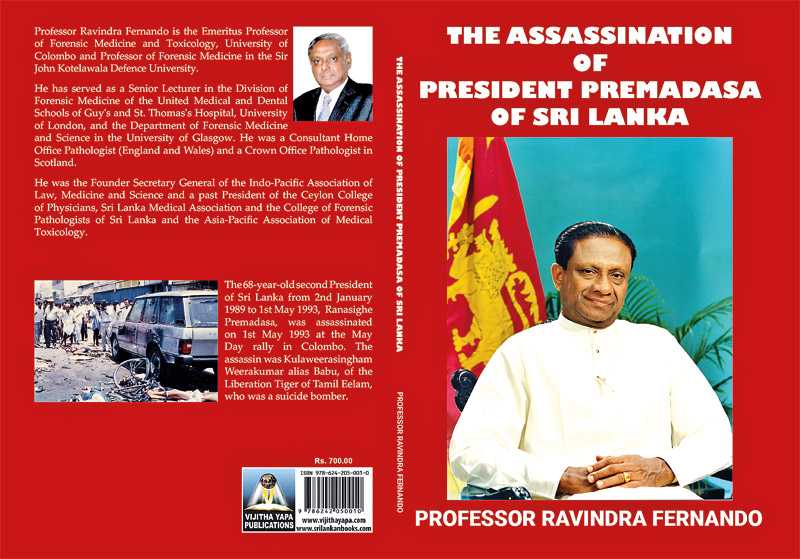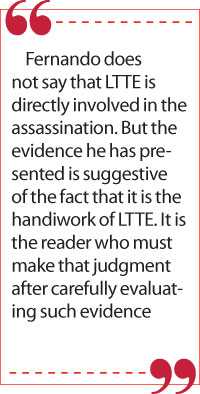Friday Dec 19, 2025
Friday Dec 19, 2025
Monday, 10 May 2021 00:30 - - {{hitsCtrl.values.hits}}

The rich information he has presented from original sources makes the book a good read for ordinary readers, legal and medical professionals, and students
 Assassination of President Premadasa
Assassination of President Premadasa
Ravindra Fernando, Colombo University’s Emeritus Professor of Forensic Medicine and now a Don at the Kotelawala Defence University’s Medical School, has been in the habit of publishing at least one book a year. Many of his books have been on controversial murder cases in Sri Lanka analysed from the point of a forensic medical expert.
Previously, he published on the Sathasivam case, Mathew Peiris case, Wijedasa Liyanarachchi case, Lalith Athulathmudali case, and the case relating to the bomb attack in Parliament. To add to this list, his 31st publication, he has now released a book analysing the assassination of President Ranasinghe Premadasa in broad daylight at a street corner in Colombo on the May Day of 1993.
Gruesome killings of LTTE
Premadasa’s assassination has been surrounded by mystery. Though fingers have been publicly pointed at the Tamil Tigers who had organised themselves as the Liberation Tigers of Tamil Eelam or LTTE, the group had denied their hand in this gruesome killing. Of course, it had been their practice to deny their role in many other similar killings like the assassination of India’s former Premier, Rajiv Gandhi. Hence, their word should not be taken as the revelation of truth.
But as Fernando has elaborated in the concluding part of his book, Indian authorities had done a thorough investigation into the case and charged the leaders of LTTE of the crime committed, despite the change of political power from Rajiv Gandhi’s Congress Party to his opponents, the Bhartiya Janata Party.
 A crime without an offender
A crime without an offender
A similar course had not been adopted by the Government of Sri Lanka. On the day of the assassination, much of the evidence had been erased by the complete cleaning of the crime scene allegedly on the orders of a top political leader of the ruling party. The reason given had been the need for averting an island-wide riot against Tamil minority which had later been proved as an unfounded fear. Hence, the standard procedure could not be followed, and the investigations had to rely on photographs taken by foreign and local journalists who had rushed to the place immediately.
One year after Premadasa’s assassination, the political power had shifted from Premadasa-led UNP to the opposition and the new rulers may not have the same interest in pursuing the case. As a result, as Fernando has revealed, 12 years after the assassination, the Government had withdrawn the case against even those who had been arrested on suspicion earlier – 40 in number – for lack of sufficient evidence. Thus, the assassination of President Premadasa is marked in history as a crime committed but without an offender.
All the evidence points to LTTE
Hence, what Fernando has done is documenting the events leading to Pemadasa’s assassination from a political, social, and scientific point so that readers could gauge who the culprits were and where the state had gone wrong. Fernando does not say that LTTE is directly involved in the assassination. But the evidence he has presented is suggestive of the fact that it is the handiwork of LTTE. It is the reader who must make that judgment after carefully evaluating such evidence.
As background information, Fernando has taken the readers through the life journey of President Premadasa and the circumstances which had led LTTE to wage war against the legally constituted government of Sri Lanka.
Premadasa, the self-made politician
Premadasa has been a politician who has started his political career as a young political cub and risen to the highest position in the country through his sheer perseverance, determination, and tenacity. According to his own words expressed often at political meetings, he had graduated from the university of life and faced more failures than successes. Each failure had taught him much important life lessons like a person, as a Sinhala saying would say, who had been tempered, an elaborate method of cooking which Sri Lankans have learned from the Portuguese. Thus, he had been a politician without a God Father to protect him. Unlike many other politicians in Sri Lanka, he did not have a strong family background to play his role in politics.
 Premadasa’s weakness: Placing unreserved trust in his valet
Premadasa’s weakness: Placing unreserved trust in his valet
Even after he became President, he had to face an insurrection by Sinhala youth in the south and Tamil youth in the north and the east. There had been a coup within the party that had led to an abortive impeachment. Through his shrewdness, he had managed to successfully beat those challenges. Yet, there was one weakness in the man as highlighted by Fernando in his book. That was the unreserved trust he had placed in his valet, Mohideen who had run the affairs at his residence, Sucharitha.
While he had been given a very strong protection elsewhere, the security at Sucharitha had been defective due to Mohideen’s addiction to liquor and women. Fernando had implied that Mohideen had been up to his vices without Premadasa’s knowledge. It is this weakness of Premadasa and addictions of Mohideen that had been capitalised by LTTE operatives to breach the protective ring in Sucharitha and have easy access even to Premadasa’s bedroom.
Babu exploiting Mohideen’s weaknesses
The LTTE operative who had been sent to Colombo by LTTE to carry out the gruesome crime, nicknamed Babu, had patiently cultivated his access link for over two years by bribing Mohideen with liquor and women and main security officers with liquor. Babu had pretended so much of innocence in his day-to-day behaviour that nobody had suspected him as a plant of LTTE to assassinate Premadasa. According to the evidence revealed, Babu had the capacity to blow Premadasa up in the sky when he was travelling to his estate in the helicopter or plant a bomb under his bed to dispose him off easily. Yet, he waited until he received orders from the high ups in LTTE.
Choosing appropriate time for assassinating Premadasa
The right opportunity for LTTE to assassinate Premadasa came when the elections were announced for the Western Province Provincial Council in the early part of 1993. A week before the day of the crime, the senior politician and Premadasa’s rival Lalith Athulathmudali was assassinated at an election rally in Colombo. The accusing finger was immediately pointed at Premadasa.
He became so nervous about the bad publicity which these stories were giving him that, at the last election meeting that was held a few hundred metres away from where Athulathmudali was assassinated, he challenged his enemies: ‘Assassinate my body but not my character which I have ardently built whole my life’.
Noticing this agony in a strong President, LTTE decided to strike. An opportunity was provided by Premadasa himself by stepping into the street to organise a May Day procession in a weak security environment. Acting on orders from his handlers, Babu, fitted with a lethal suicide bomb kit to his body, blew up Premadasa and all others who were around him at that time at a street corner in Colombo.
The bloody scene at the site of the crime
Fernando has vividly explained the bloody carnage that had been created by this powerful bomb explosion. There had been human flesh strewn everywhere. Some of the bodies were beyond recognition. That applied to Premadasa too. For the time being, nobody knew what happened to him. Fernando describes how his body was found among other dead bodies: “Next to these two bodies, there was another body on the ground under a stretcher. The body was clad in a short-sleeved shirt and a sarong. There was a wristwatch. The face was damaged beyond recognition due to the blast. The officers identified the body. It was that of President Premadasa”.
Babu too had been blown up into pieces. Inspector of Police Jayasinghe who was at the scene had described it as follows: “There was a body lying upwards, broken below the waist. The upper part of the body was not to be seen. About 12 feet 4 inches from the body there was a head on the right side of Armour Street. There was a hand a few feet away from the head. On the middle of the road, there were two National Panasonic batteries. One was 31 feet 8 inches from the bicycle and the other 31 feet from the bicycle. Pieces of the bomb and parts of the bodies were spread across the road”. That was how LTTE in its heyday struck terror among people by blowing up a very powerful Executive President in his own locality by using a simple but determined assassin called Babu.
 A forensic analysis of the crime
A forensic analysis of the crime
Fernando’s objective of publishing the book had been to analyse the forensic side of the whole episode. That he has done by referring to the findings of forensic examinations done by other experts and reproducing a special report which he had prepared on the orders of the Colombo Magistrate who heard the case. Since he himself had not been involved in the original forensic examinations, this report had been prepared by him by making learned judgments on the findings done by others.
Post-mortem of Babu
Babu’s post-mortem was done by Colombo’s Judicial Medical Officer, Dr. L.B.L. de Alwis. Babu’s body had been dismembered and fragmented due to the force of the bomb that had been fitted to his body. Dr. de Alwis, following the due procedure to be observed when conducting the post-mortem of a dead body, had recorded all the details of the injuries which Babu had inflicted on himself when blowing up others in the scene. It was in fact creation of a story out of fragments which had been owned by a whole body prior to the explosion of the bomb.
The most important evidence found was the broken cyanide glass capsule that had been buried to the flesh of the neck, a must which every LTTE cadre should carry with him to take his own life in the event of being captured by security forces. This signature LTTE brand was a testimony that the assassination of President Premadasa was carried out by LTTE, though the organisation had denied its hand in the crime.
Post-mortem of Premadasa
The post-mortem on the body of President Premadasa was also conducted by Dr. de Alwis. This was how he saw the body of the President: “The entire body showed superficial burns, blackening and tattooing. Multiple, circular, oval, elongated, linear and guttered perforating lacerations were observed in the entire body. Due to injuries, there were deformities of the head, face, upper limbs, and lower limbs. Intestines were protruding out through a large laceration of the anterior abdominal wall”. Though the body had not been dismembered, it had been disfigured due to multiple external and internal injuries. Given the power of the bomb used, President Premadasa would not have survived it.
Fernando has explained in detail the post-mortem examinations conducted on other bodies that had been found in the scene.
Fernando’s special report
Fernando was commissioned by Colombo’s Additional Magistrate to present a special expert opinion on all the post-mortem examinations conducted. This he presented in August 1994 and has been fully reproduced in his book. In his report, he has noted the following deficiency: “However, it was unfortunate that the scene was not preserved for a thorough and careful examination by forensic experts of the Government Analyst Department and the experts from the Scotland Yard, who were in the island at the time. They could not inspect the scene and contribute to the investigation”.
Fernando has concluded the report making the following five expert opinions:
1.The deaths of His Excellency the President Ranasinghe Premadasa and others were the result of a bomb explosion.
2.The pattern and the extent of the injuries clearly indicated that the person who was closest to the explosion or who carried and detonated the explosive device was the person identified as Kulaweerasingham Weerakumar.
3.The pattern and the extent of the injuries on the body of His Excellency the President Premadasa indicated that he was very close to and facing the direction of the explosion.
4.The presence of chemical substances of the nitro group on many items recovered confirms that the explosives contained the well-known nitro compounds.82
5.Considering all the information available, it is my opinion that the explosion at Armour Street Junction of the 1st May 1993, which caused death of His Excellency the President other others, was the result of an explosive that was carried and detonated by Kulaweerasingham Weerakumar.
He has also made a very valuable last statement in his report which is valid even today: “As in all political assassinations, the investigation is incomplete unless the motive and those responsible for the lone assailant to carry out the act, if any, are determined”.
A book for every reader
This book is short relative to his other publications. But the rich information he has presented from original sources makes the book a good read for ordinary readers, legal and medical professionals, and students.
(The writer, a former Deputy Governor of the Central Bank of Sri Lanka, can be reached at [email protected].)